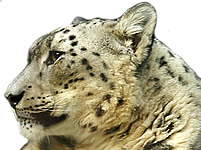| Bhutan's
Nature - Animals |
 |
Bhutan Nature Animals |
|
 |
Bhutan Information |
|
|
 |
| Snow Leopard |
 |
 |
| The snow leopard has long, thick smoky gray fur with dark rosettes and spots,
and a very long thick tail. Weighing up to 75 kg , it has large, well-cushioned
paws, a strong chest, and short forelimbs that enable it to scale outcroppings
high on cliffs. Further adaptations for high-altitude life include long
hair with dense, woolly underfur and an enlarged nasal cavity. |
|
 |
|
Throughout
its range, the snow leopard is mostly associated with steep, dry, rocky
terrain with shrub or grassland vegetation. the snow leopard lives above
the tree line, where it hunts. It is generally found at elevations between
3000 - 4500 m. The snow leopard is an opportunistic predator. Its most common
prey includes wild sheep and goats, but it also eats marmots, pikas, hares
and game birds (chukor partridge and snowcocks), as well as domestic
sheep and goats.
Snow
leopards rarely descend into the coniferous forest belt and are most frequently
spotted north of the main Himalaya along the Tibetan border. Ibex and bharal
are primary food items in large parts of their range, but with the depletion
of native ungulates, snow leopards have turned to livestock for sustenance.
Strong and solitary, they nevertheless communicate to each other through
signs such as scrapes.
Snow
leopard population indices were estimated in areas of northeastern Bhutan.
The Bhutan site consisted of open moist grasslands above timberline on
the southern side of the Himalaya.
Factors
such as the relatively open terrain and moist climate (e.g., heavy winter
snow) appear to reduce habitat quality for snow leopard in Bhutan,
so that in spite of the higher blue sheep density there are perhaps only
1-2 snow leopards per 100 km2 on average at the Bhutan site.
The blue sheep is one of its major prey. One must also consider that different topography,
primarily differential presence of valley bottom cliffs and ridgetop outcrops
(marking sites), can affect sign density, and general topography as well
as livestock density probably influences snow leopard hunting success.
top
| Wildlife and People in Bhutan |
 |
| Information on Bhutan |
 |
| Links |
 |
|




